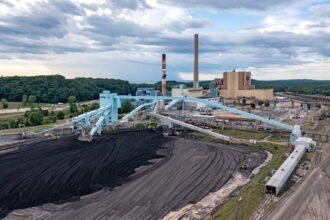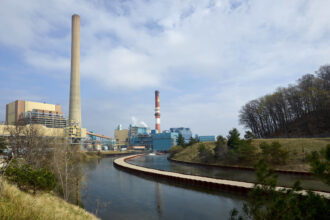The towering smokestacks of New England’s last coal-fired power plant have gone quiet. Merrimack Station in Bow, New Hampshire, shut down in September, years ahead of its scheduled closure, marking the end of coal-fired energy production in the region.
Merrimack Station had supplied electricity to the region since the 1960s. But as coal’s financial viability waned and environmental pressures mounted, the era of coal power production in New England may now be officially over. In the coming years, on-site solar and battery storage could take coal’s place at the site.
Granite Shore Power, Merrimack Station’s owner, officially ceased operations on Sept. 12. A 2024 settlement between the company, the Conservation Law Foundation, the Sierra Club and the Environmental Protection Agency over alleged Clean Water Act violations had required the facility to close by 2028. The early retirement underscores how coal has become economically untenable in the region.
“Coal has been challenged in New England for twenty years,” said Dan Dolan, president of the New England Power Generators Association. “The market no longer sustains and justifies these types of facilities.”
The station’s 438-megawatt output has steadily declined over the past two decades. Once operating at 70 to 80 percent capacity in the early 2000s, Merrimack has failed to exceed 8 percent in the past six years, running only during periods of peak electricity demand.
Older, larger coal plants like Merrimack Station, despite running only during peak periods, take a long time to power up, Dolan explained. More flexible, faster-starting natural gas “peaker” plants have now taken their place.
ISO New England, the nonprofit organization that operates the region’s electricity grid and oversees the wholesale power market, explained that it dispatches the cheapest sources first and most often—meaning coal plants like Merrimack were called upon less frequently as more affordable options became available.
Across New England, coal use fell by more than 90 percent between 2007 and 2017, displaced by cheaper natural gas and renewable power.
Entering the first New England winter without coal, the impact on the grid will be minimal. Merrimack Station accounted for just 0.22 percent of the region’s electricity generation in 2024, according to ISO New England. That shortfall can be replaced by renewables, natural gas and power imports from neighboring states.
The shutdown marks the end of a long, contentious chapter in environmental activism. In addition to litigation, Merrimack Station has been a flashpoint for protests for years.
The No Coal No Gas campaign, spearheaded by 350 New Hampshire and the Climate Disobedience Center, began in 2019 with the goal of shutting down the station. Activists staged a series of civil disobedience actions, including attempts to “liberate” coal before combustion, blockading shipments, and even occupying the station’s smokestack. Over the years, the campaign has resulted in over a hundred arrests and drawn national attention to New England’s lingering dependence on fossil fuels.
“We’re very excited,” said Rebecca Beaulieu of 350 New Hampshire. In 2023, Merrimack Station failed an emissions test that found particulate matter levels 70 percent above federal limits, along with elevated mercury and nitrogen oxide, and for every hour the plant operated, it emitted more carbon dioxide than the average American does in 26 years. “Knowing the plant will never power up again, even for an hour, is a huge relief,” she said.
While the closure brings uncertainty for Merrimack Station employees, many of whom have been transferred to other Granite Shore Power sites, both activists and the utility hope that the station’s next phase will present new job and economic opportunities for New Hampshire.
“The historic agreement with the EPA paves the way for first-of-their-kind ‘Renewable Energy Parks’ in the state,” Granite Shore Power said in a statement last year. Both Merrimack Station and Schiller Station—another Granite Shore Power facility that ended coal operations in 2020 —are slated to be converted into renewable energy and battery storage sites. The company says roughly 400 acres of land and existing grid infrastructure will make the transition possible.
Granite Shore Power credited the Inflation Reduction Act for helping make its renewable-energy plans financially feasible. But with the Trump administration moving to roll back renewable-energy incentives, the policy environment for such projects has grown uncertain.
Just weeks after Merrimack Station shuttered, the administration announced that the Department of Energy would invest $625 million in coal-related projects aimed at reviving the industry. Federal officials have not commented on the plant’s closure.
As Granite Shore Power enters a new era of coal free energy production, the No Coal No Gas campaign is turning towards oil- and gas-fired peaker plants that operate during peak demand times, including two kerosene turbines at the Merrimack Station site.
“These inefficient oil and gas facilities receive monthly ratepayer subsidies, but sit idle most of the year,” the campaign said in a statement. “When they are called to operate at times of high electricity demand, they do so with extra-high pollution at extra-high costs.”
About This Story
Perhaps you noticed: This story, like all the news we publish, is free to read. That’s because Inside Climate News is a 501c3 nonprofit organization. We do not charge a subscription fee, lock our news behind a paywall, or clutter our website with ads. We make our news on climate and the environment freely available to you and anyone who wants it.
That’s not all. We also share our news for free with scores of other media organizations around the country. Many of them can’t afford to do environmental journalism of their own. We’ve built bureaus from coast to coast to report local stories, collaborate with local newsrooms and co-publish articles so that this vital work is shared as widely as possible.
Two of us launched ICN in 2007. Six years later we earned a Pulitzer Prize for National Reporting, and now we run the oldest and largest dedicated climate newsroom in the nation. We tell the story in all its complexity. We hold polluters accountable. We expose environmental injustice. We debunk misinformation. We scrutinize solutions and inspire action.
Donations from readers like you fund every aspect of what we do. If you don’t already, will you support our ongoing work, our reporting on the biggest crisis facing our planet, and help us reach even more readers in more places?
Please take a moment to make a tax-deductible donation. Every one of them makes a difference.
Thank you,













